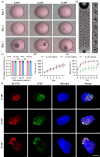The hanging-heart chip: A portable microfluidic device for high-throughput generation of contractile embryonic stem cell-derived cardiac spheroids
- PMID: 40385551
- PMCID: PMC12079401
- DOI: 10.1002/btm2.10726
The hanging-heart chip: A portable microfluidic device for high-throughput generation of contractile embryonic stem cell-derived cardiac spheroids
Abstract
Stem cell-derived cardiac spheroids are promising models for cardiac research and drug testing. However, generating contracting cardiac spheroids remains challenging because of the laborious experimental procedure. Here, we present a microfluidic hanging-heart chip (HH-chip) that uses a microchannel and flow-driven system to facilitate cell loading and culture medium replacement operations to reduce the laborious manual handling involved in the generation of a large quantity of cardiac spheroids. The effectiveness of the HH-chip was demonstrated by simultaneously forming 50 mouse embryonic stem cell-derived embryonic bodies, which sequentially differentiated into 90% beating cardiac spheroids within 15 days of culture on the chip. A comparison of our HH-chip method with traditional hanging-drop and low-attachment plate methods revealed that the HH-chip could generate higher contracting proportions of cardiac spheroids with higher expression of cardiac markers. Additionally, we verified that the contraction frequencies of the cardiac spheroids generated from the HH-chip were sensitive to cardiotoxic drugs. Overall, our results suggest that the microfluidic hanging drop chip-based approach is a high-throughput and highly efficient method for generating contracting mouse embryonic stem cell-derived cardiac spheroids for cardiac toxicity and drug testing applications.
Keywords: cardiac spheroids; embryonic stem cell; hanging‐heart chip.
© 2024 The Author(s). Bioengineering & Translational Medicine published by Wiley Periodicals LLC on behalf of American Institute of Chemical Engineers.
Conflict of interest statement
The authors declare that they have no conflict of interest.
Figures





Similar articles
-
A microfluidic hanging drop-based spheroid co-culture platform for probing tumor angiogenesis.Lab Chip. 2022 Mar 29;22(7):1275-1285. doi: 10.1039/d1lc01177d. Lab Chip. 2022. PMID: 35191460
-
A PDMS-Based Microfluidic Hanging Drop Chip for Embryoid Body Formation.Molecules. 2016 Jul 6;21(7):882. doi: 10.3390/molecules21070882. Molecules. 2016. PMID: 27399655 Free PMC article.
-
Seamless Combination of Fluorescence-Activated Cell Sorting and Hanging-Drop Networks for Individual Handling and Culturing of Stem Cells and Microtissue Spheroids.Anal Chem. 2016 Jan 19;88(2):1222-9. doi: 10.1021/acs.analchem.5b03513. Epub 2016 Jan 6. Anal Chem. 2016. PMID: 26694967 Free PMC article.
-
Human-induced pluripotent stem cell-derived cardiomyocytes, 3D cardiac structures, and heart-on-a-chip as tools for drug research.Pflugers Arch. 2021 Jul;473(7):1061-1085. doi: 10.1007/s00424-021-02536-z. Epub 2021 Feb 24. Pflugers Arch. 2021. PMID: 33629131 Free PMC article. Review.
-
Application of Single Cell Type-Derived Spheroids Generated by Using a Hanging Drop Culture Technique in Various In Vitro Disease Models: A Narrow Review.Cells. 2024 Sep 14;13(18):1549. doi: 10.3390/cells13181549. Cells. 2024. PMID: 39329734 Free PMC article. Review.
References
LinkOut - more resources
Full Text Sources

